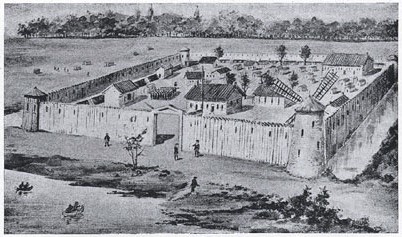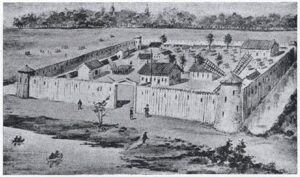
The Lachine Massacre (August 4-5, 1689)
The Lachine Massacre was a devastating attack on the French settlement of Lachine, located near modern-day Montreal, on the nights of August 4-5, 1689. A force of approximately 1,500 Iroquois warriors, motivated by longstanding tensions with the French, territorial disputes, and revenge for prior French military actions against their villages, launched the assault.

The massacre began as soon as the Iroquois warriors landed at Lachine. Armed with both firearms and traditional weapons, they struck swiftly and mercilessly. Over the course of the night and into the early morning hours, two hundred French settlers and soldiers were killed, while another one hundred and twenty were captured. The Iroquois did not discriminate between men, women, or children, and many of the victims were either killed outright or taken prisoner to be transported to the Iroquois villages.
The French Response and the Battle for Survival
At the time of the attack, Governor Louis de Buade de Frontenac had stationed a small French garrison at Fort Roland, near Lachine, under the command of Monsieur de Vaudreuil. Upon hearing of the attack, de Vaudreuil gave the order to the garrison at Fort Remy to join him in reinforcing the defense of Lachine. As the troops marched down the main road toward the settlement, the Iroquois launched a surprise assault on them. The Iroquois ambush was devastating, and nearly all of the attacking warriors were killed in the ensuing battle.
However, the French forces were unable to prevent the massacre of the settlers. Among the French soldiers, the Iroquois captured several, including Lieutenant La Rabeyre, La Plante, and Villedonne. The future baron of Longueuil was one of the few to escape, despite a broken limb, thanks to some friendly Iroquois who spared him and carried him to safety.
The Fate of the Captives
The captives taken by the Iroquois were subjected to extreme cruelty and torment. Many were tortured, and others were burned alive as part of the Iroquois’ ritualistic acts of revenge. The survivors, including La Rabeyre, La Plante, and Villedonne, were forced to endure further humiliations. They were marched from the Lachine area, across Lake St. Louis, and beyond, suffering physical abuse and deprivation along the way. They were taken to the Iroquois village of Onnontague (modern-day Onondaga) and were subjected to further torture, including being made to walk barefoot on a bed of live coals.
The French captives were then enslaved and forced to work as servants and porters for the Iroquois in their military expeditions. This servitude, particularly for La Plante and Villedonne, lasted for more than two years. During this time, La Plante adapted to his captors’ ways, learning the Iroquois languages and culture, which ultimately aided in his survival.
The Rescue of La Plante and Villedonne
In February 1692, a French military expedition commanded by Monsieur de Beaucourt launched a daring raid on an Iroquois encampment near the island of Tonihata (Toniata), in what is today the Thousand Islands region of the St. Lawrence River. The raid was a success, and La Plante was among those freed. According to Father Charlevoix, who chronicled the event, La Plante was initially mistaken for an Iroquois warrior due to his attire, which consisted of traditional Iroquois clothing. Charlevoix wrote, “Not having been recognized at first sight in his Indian clothes, we thought to have him killed as an Iroquois.”
The rescue marked a pivotal moment in La Plante’s life. In recognition of his bravery and service, he was promoted to the rank of infantry ensign by Governor Frontenac. His promotion was confirmed by King Louis XIV in an official order dated March 1, 1693.
The Provocation Leading to the Massacre
The Lachine Massacre was, in part, a response to French actions earlier that year. The French, under Frontenac’s command, had launched a series of aggressive campaigns against the Iroquois, including the destruction of Iroquois villages and the burning of their winter food caches. These actions left the Iroquois people without shelter or food, leaving them vulnerable to starvation as the harsh winter months approached. In retaliation, the Iroquois launched the attack on Lachine, a small but strategic settlement that had been largely unprotected due to the ongoing tensions between the French and Iroquois.
Aftermath and Legacy
The Lachine Massacre had far-reaching consequences. It not only deepened the animosity between the French and the Iroquois but also marked a turning point in the history of New France. The devastating loss of life at Lachine and the trauma inflicted on the survivors fueled French resolve to protect their territories, leading to further military engagements between the French and Iroquois over the next several decades.
The massacre also highlighted the vulnerability of the French colonial settlements, which were largely isolated and poorly defended against Iroquois raids. The aftermath of the attack prompted French authorities to reconsider their military strategy, ultimately leading to more fortified settlements and an increased French military presence in the region.
In the years following the massacre, the French and Iroquois continued to clash, with both sides suffering heavy losses. However, the French eventually gained the upper hand, and the Iroquois were forced to cede significant territory to the French.
The Lachine Massacre remains one of the most brutal and tragic events in the early history of New France. It serves as a reminder of the fierce struggles for territory, survival, and revenge that characterized relations between the French and Indigenous nations during this period.
Historical Significance
The Lachine Massacre is significant not only for its brutality but also for its impact on the course of North American history. The massacre marked a turning point in the relations between the French and Iroquois, leading to increased tensions and conflict between the two groups.
The massacre also had significant implications for the development of New France. The French authorities’ response to the massacre, including the construction of more fortified settlements and the increased military presence, helped to establish a more secure foothold for the French in North America.
In addition, the Lachine Massacre serves as a reminder of the complex and often fraught history of Indigenous-European relations in North America. The massacre highlights the violence and trauma that often accompanied the colonization of Indigenous lands and the displacement of Indigenous peoples.
Conclusion
The Lachine Massacre was a devastating and tragic event that had far-reaching consequences for the history of New France and the relations between the French and Indigenous nations. The massacre serves as a reminder of the complex and often fraught history of Indigenous-European relations in North America and highlights the need for ongoing reconciliation and healing.
References:
- Charlevoix, Pierre-François-Xavier de. “Histoire de la Nouvelle-France.”
- Thwaites, Reuben Gold, ed. “The Jesuit Relations and Allied Documents.”
- Francis, Daniel, ed. “The History of Canada: Volume 1 – From the Origins to the French Conquest.”
- Greer, Allan. “The Iroquois and the French in the Seventeenth Century.”
- Wilson, James. “A History of the Iroquois.”
- Borneman, Walter R. “The French and Indian War: A History.”
- Little, Barbara J. “The Iroquois in the American Revolution.”
Related articles: